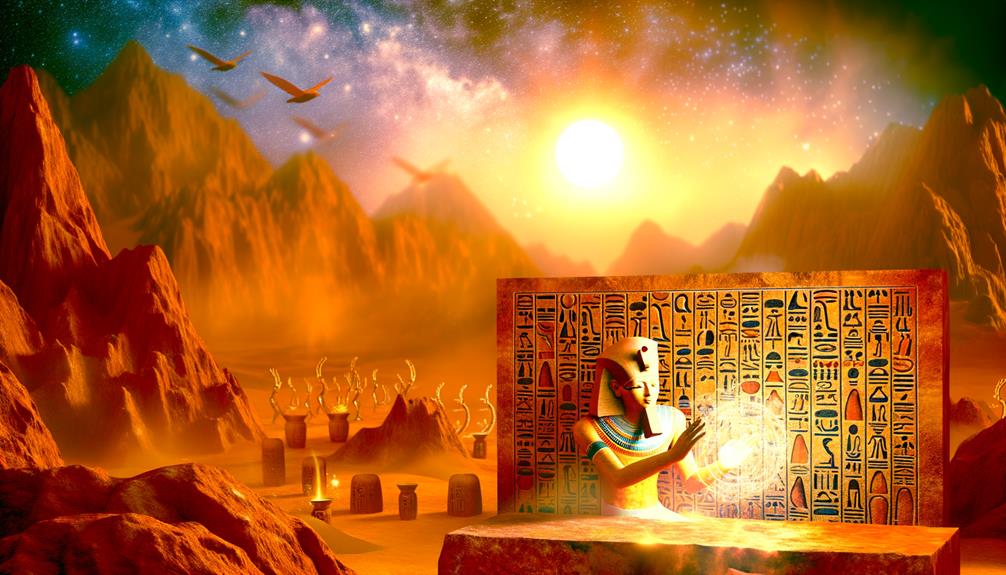Ptah, the ancient Egyptian god of creation, is a bit like a jigsaw with pieces missing. There are gaps in what we know about this intriguing figure, despite the vast amounts of time I've dedicated to reading the old scripts, interpreting hieroglyphics, and examining the artifacts left behind by this ancient civilization. His role as the protector of craftsmen and architects, and his importance in death ceremonies, make him a riveting character to study.
But what really grabs my attention is his position as a god of creation. Ptah, as legend tells us, spoke the world into existence using his heart and tongue. How did this belief shape the religious and societal views of ancient Egypt? This is just one of many questions we'll be addressing as we delve into the mysteries of Ptah, also referred to as the Lord of Truth. Join me as we venture together into uncovering the hidden truths about Ptah.
Understanding Ptah's Origins

Let's talk about the origins of Ptah, which is truly intriguing. This Egyptian creator god is seen as the entity who voiced the world into being. His roots trace back to the city of Memphis, and from there, Ptah's influence radiated across Egypt, most notably during the Old Kingdom era. His ties to speech and creation are key in understanding where Ptah comes from.
Ptah, who is thought to have formed the world with his verbal expressions, is often shown as a green-skinned man, wrapped in a shroud, and holding a sceptre. This sceptre stands for his power, life, and stability. The temple of Ptah, a crucial place of worship, further emphasizes the significance of this Memphis deity.
There's a vital artifact from this period, the Shabaka Stone, carrying inscriptions about Egyptian Creation that provide a deep understanding of Ptah's part in this story. This stone also reveals the Kushite rule in Egypt and their ties to Memphis. These details speak to Ptah's reputation as the 'begetter of the first beginning', a testament to his enduring influence as a creator god in Egyptian mythology. As we discuss this, the layers and intricacies of Ptah's mythology are truly stunning.
Symbolism and Epithets of Ptah
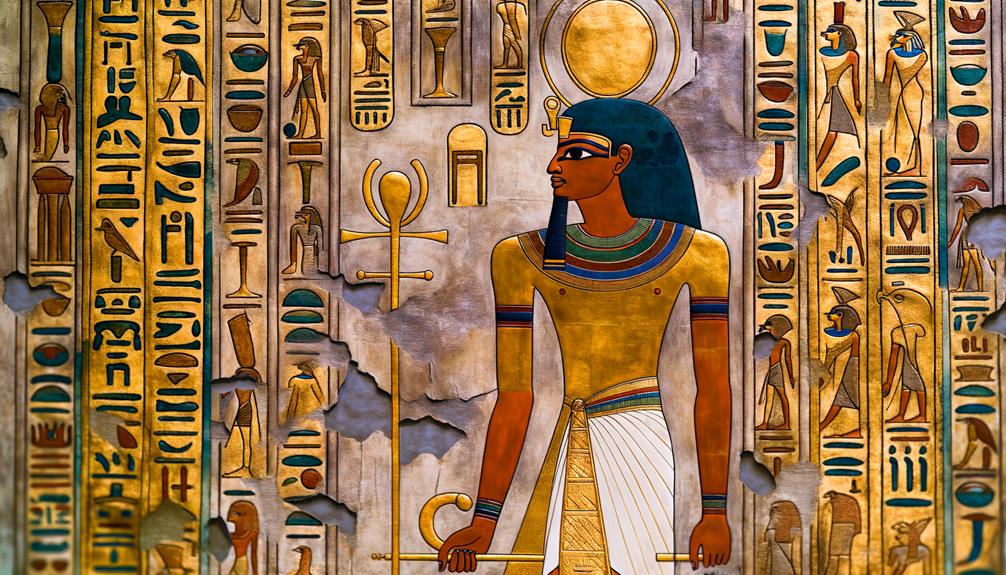
If we take a closer look at the complex symbolism and numerous titles given to Ptah, we see a fascinating blend of meanings that highlight his role and significance in Egyptian mythology. As the revered ancient god of Memphis, Ptah's importance was symbolized in the grand temple in Memphis.
Ptah's representations are steeped in symbolism. He was often shown as a dwarf or a mummified man, with green skin and donning the Atef crown, embodying life's nourishing aspects. His patronage extended to craftsmen and architects, indicating his widespread influence in Egyptian society.
Ptah was respected as a figure of honesty and eternity, evident from titles such as 'lord of truth' and 'lord of eternity.' His ties with the sun god show his crucial role in Egyptian religion and the creation story, given the sun's strong representation of rebirth and renewal.
The Shabaka Stone, an ancient artifact, offers more proof of Ptah's central position among the Egyptian gods. It emphasizes his role in the creation story, strengthening his significance in the religious and cultural tapestry of ancient Egypt.
Ptah's Representation in Ancient Art
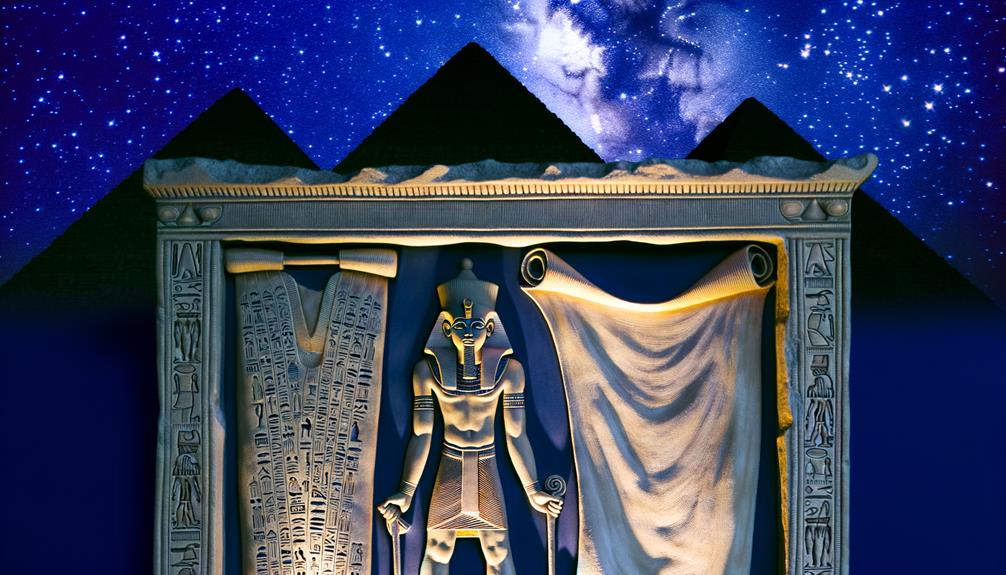
Looking at ancient Egyptian art, you'll find a ton of artwork that highlights Ptah's respected position and various roles within their gods' circle. Dating back to the Old Kingdom's early dynastic period, he's often depicted as a mummified man, tied to the god of the Dead. This imagery underscores his role as both a creator and the one who maintains life.
You'll also see a lot of Ptah's art on the Shabaka Stone, an artifact from Pharaoh Shabaka's era. On this stone, Ptah is part of the Memphite Triad, with his wife Sekhmet and their son Nefertem by his side. This shows how important he was in both Upper and Lower Egypt.
A really vivid representation of Ptah is on the monumental statue of Ramesses II. There, he's shown quite small, placed at the pharaoh's feet. This image hints at Ptah's protective nature and his close ties with the pharaohs.
Ptah's falcon form, though less common, is also worth noting. It represents his connection with the sky, adding another layer to his roles within the rich Egyptian mythology. This range of visual representation mirrors Ptah's complex persona and his deep significance to the ancient Egyptians.
Development and Influence of Ptah's Cult
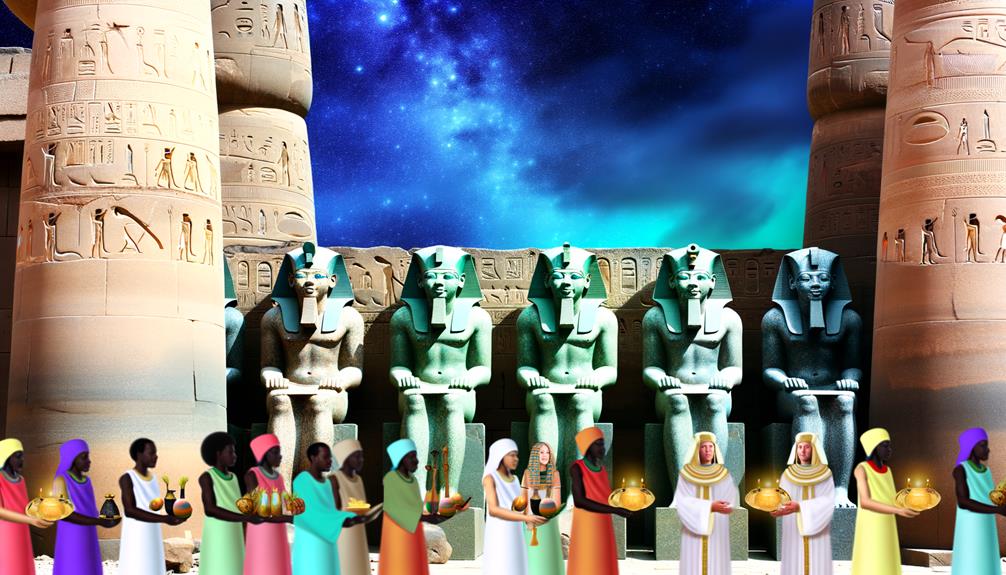
Ptah, the much-revered god of ancient Egypt, was known for his many depictions in art. But to really appreciate his impact, you'd need to delve into the history and footprint of his cult. Let me take you back to Memphis, an ancient Egyptian city where Ptah's cult first took root. From there, it spread all over Egypt during the Old Kingdom, a period famous for its royal pyramid projects.
- The growth of Ptah's cult was quite impressive. It managed to imprint itself all over Egypt, largely due to the high priests of Ptah. These folks were often chief architects and master craftsmen, embedding the worship of Ptah into Egypt's architectural landscape.
- Ptah was tied to the power of creative speech, reinforcing his reputation as a god of creation.
- The influence of Ptah's cult wasn't just limited to religious practices. You could see it in the day-to-day life of the ancient Egyptians as well. They placed images and amulets of Ptah in their tombs, banking on his divine protection.
Even around 41 centuries later, during the time of the Romans, Ptah's cult still held sway, testifying to the enduring appeal of Ptah's worship.
Mysteries Surrounding Ptah's Worship
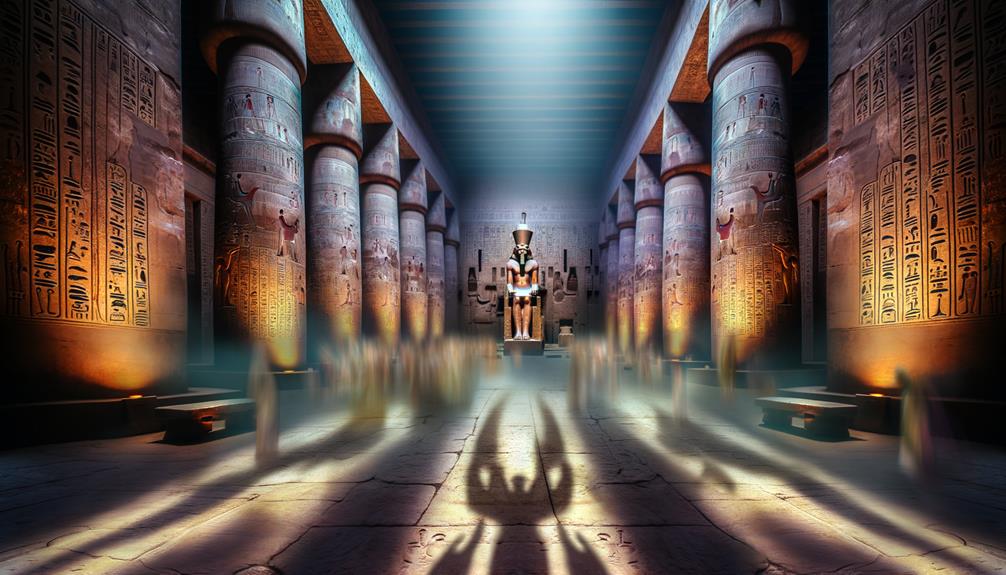
You might find yourself pondering over the enigmas that encircle the worship of Ptah, an Egyptian god famed for his potent speech and countless representations. Back in the era of the New Kingdom, Ptah's sway spiked as Memphis, his regional divinity, gained prominence. Yet, the finer aspects of his worship stay concealed, much like Ptah himself in his symbolic white attire.
The Oxford University Press has observed an intriguing shift in how Ptah was depicted during the Third Intermediate Period. His figure, painted green, which symbolized rebirth, began to portray the mummified body of Osiris, a symbol of resurrection. However, the reasoning behind this connection with Osiris is still up for discussion. Could it be that Ptah, the god known for 'giving life', was being associated with life after death?
An interesting artifact from this period resides with the Trustees of the British Museum. It's a shrine dedicated to Ptah, intricately illustrating rituals and offerings, suggesting a matured, intricate form of Ptah worship. However, the inscriptions are not as clear and suggest the existence of some practices that have disappeared over time.
The mysteries associated with Ptah's worship continue to pique the interest of scholars and contribute to our comprehension of this complex god. They serve as a reminder of the cryptic nature of ancient religions and the way their gods were depicted.
Frequently Asked Questions
What Is the Ptah Creation Myth?
Let's talk about the Ptah creation myth. It's a fascinating story from ancient Egypt that says Ptah, a god, used his heart and words to dream up and bring the world into existence. It's all about the idea that thinking and speaking can be powerful enough to create entire worlds. This compelling tale really makes you appreciate the might of thoughts and the weight of words, doesn't it?
What Did Ptah Invent?
Isn't it fascinating that Ptah, rather than just creating a simple object, is credited with the creation of the whole world? Using his heart and tongue as tools, he breathed life into all the gods. Isn't it remarkable? Furthermore, he is considered the first source of inspiration for craftsmen. Now, isn't that something to reflect on?
What Are Some Facts About the God Ptah?
Isn't Ptah, the Egyptian deity, truly intriguing? If you look at his depictions, you'll often find him with green skin and a majestic beard. He's more than just an image, though. He's known for being the embodiment of truth and eternity. And get this – according to legends, he brought the world into existence simply by speaking it into being. How's that for impressive?
Who Is the God of Mystery in Egypt?
Have you ever wondered about the enigmatic deity of Egypt? Well, let's chat about Amun, or as he's also known, Amun-Ra. This figure is often called 'the hidden one', and this name isn't just for show. It actually represents the cryptic aspects of existence and creation that are beyond our human comprehension. How intriguing is that?

